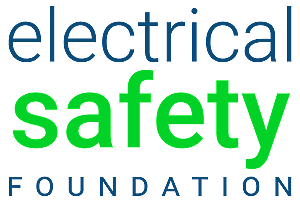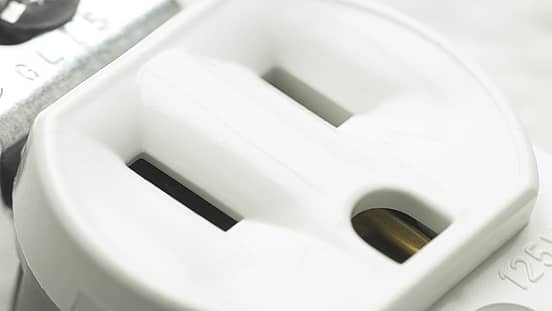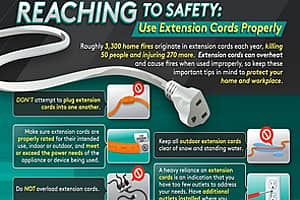- D.I.Y. Facts and Statistics
- D.I.Y. Safety Tips
- Power Tools and Equipment Safety Introduction
- Power Tool Facts and Statistics
- Power Tool Safety Tips
- Personal Protective Equipment (PPE)
D.I.Y. Introduction
Each year, thousands of people in the United States are critically injured and electrocuted as a result of electrical fires, accidents, electrocution in their own homes.
The current economic downturn has inspired more homeowners to tackle do-it-yourself projects than ever before. Faced with declining home values and aging properties, homeowners may choose not to pay for the services of a licensed electrician.
However, most do not have the training or experience needed to safely perform home electrical work, increasing the risk of immediate injuries and electrocutions and potentially introducing new dangers into the home. Working with electricity requires thorough planning and extreme care, and cutting corners can be a costly mistake.
D.I.Y. Facts and Statistics
- Spending on home improvements and repairs totaled $275 billion in 2011.
- There is an estimated average of 70 electrocution fatalities associated with consumer products per year.
- The most recent data from the U.S. Consumer Product Safety Commission shows that there are nearly 400 electrocutions in the United States each year.
- Approximately 15 percent of electrocutions are related to consumer products. Wiring hazards, including damaged or exposed wiring and household wiring, accounted for nearly 14 percent of these deaths.
- An estimated 360,900 residential building fires are reported to United States fire departments each year and caused an estimated 2,495 deaths, 13,250 injuries and $7 billion in property losses. The leading cause of the largest fires was electrical malfunction.
- There are about 37,000 nail-gun injuries each year; a 200% increase since 1991.
- Electrical failure accounted for 89 percent of electrical fires in residential buildings from 2003-2005.
D.I.Y. Safety Tips
ESFI strongly recommends hiring a qualified, licensed electrician to perform any electrical work in your home. However, if you do decide to do-it-yourself, consider the following important safety tips before undertaking any home electrical project:
- Make an effort to learn about your home electrical system so that you can safely navigate and maintain it.
- Never attempt a project that is beyond your skill level. Knowing when to call a professional may help prevent electrical fires, injuries, and fatalities.
- Always turn off the power to the circuit that you plan to work on by switching off the circuit breaker in the main service panel.
- Be sure to unplug any lamp or appliance before working on it.
- Test the wires before you touch them to make sure that the power has been turned off.
- Never touch plumbing or gas pipes when performing a do-it-yourself electrical project.
Power Tool and Equipment Safety
Many do-it-yourself projects involve the use of power tools. Working with power tools requires skilled instruction and training. They can be deadly if not properly used or maintained.
The most common scenario for power tool-related electrocutions is when the equipment comes in contact with live electrical wires while it is being used.
Facts and Statistics
- According to the U.S. Consumer Product Safety Commission (CPSC), there are nearly 400 electrocutions in the United States each year.
- Approximately 15% of electrocutions are related to consumer products.
- 8% of consumer product-related electrocutions each year are attributed to electrical accidents with power drills, saws, sanders, hedge trimmers, and other electric power tools.
- 9% of consumer product-related electrocutions each year are caused by accidents involving the use of lawn and garden equipment and ladders, which come into contact with overhead power lines.
Power Tool Safety Tips
- Use ground fault circuit interrupters (GFCIs) with every power tool to protect against electric shocks.
- Do not use power tools with an extension cord that exceeds 100 feet in length.
- Never use power tools near live electrical wires or water pipes.
- Use extreme caution when cutting or drilling into walls where electrical wires or water pipes could be accidentally touched or penetrated.
- If a power tool trips a safety device while in use, take the tool to a manufacturer-authorized repair center for service.
- When working with electricity, use tools with insulated grips.
- Appropriate personal protective gear should be worn when using power tools.
- Do not use power tools without the proper guards.
- When using a wet-dry vacuum cleaner or a pressure washer, be sure to follow the manufacturer’s instructions to avoid electric shock.
Personal Protective Equipment (PPE)
- Safeguards on outdoor electric tools are there for a reason. Make sure that they are always in place before operating.
- Invest in the safety goggles, hearing protection, dust masks, gloves and other safety gear as recommended for each tool. A few dollars now are well worth the lifetime of good sight and hearing that they are protecting.
- Wear the appropriate clothes for the job. Wearing sandals while mowing the lawn is just asking for trouble.






